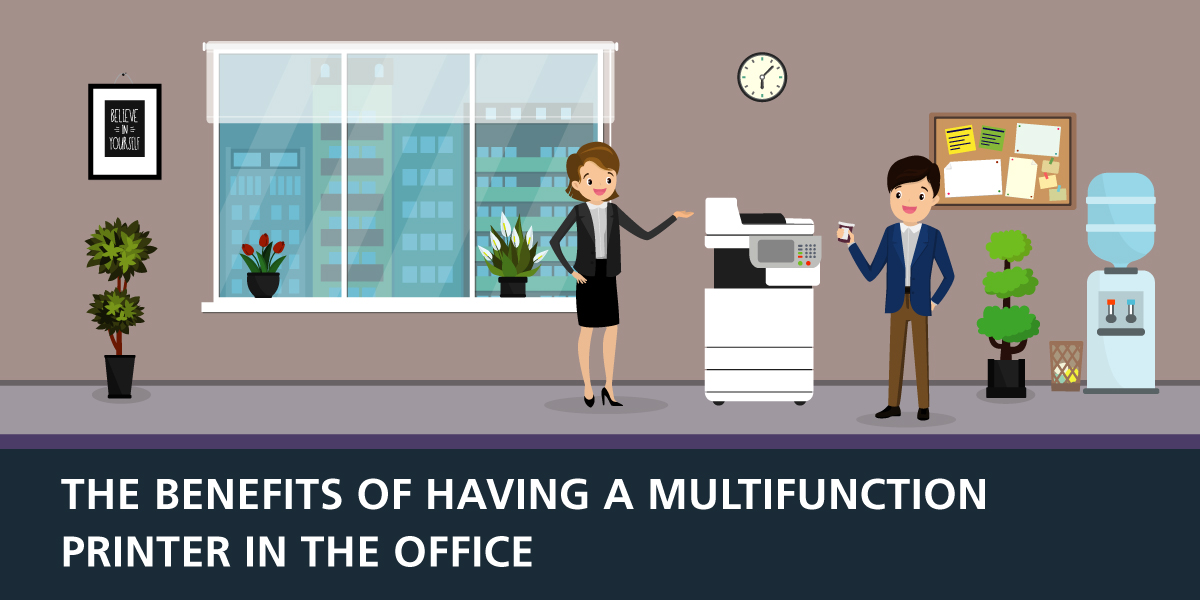Pros & Cons: Inkjet or Laser Multi-Function Printer for Business

The multi-function printer is designed to do it all: printing, scanning, and copying in color or grayscale. However, with the immense selection of printers available, how does a small office or large organization decide which is best? The answer depends on an organization’s printing needs and habits. Outlined below are the pros and cons of an inkjet or laser multi-function printer for business use.
Inkjet vs. Laser: What Is the Difference?
Inkjet and laser printing are two different types of printing technologies. Understanding this explains why they produce different printing results.
Inkjet printers print tiny dots of different color inks which are combined on paper, creating a wide range of colors. When printing photograph-quality images on regular paper from an inkjet printer, the print may still feel wet for several minutes since there is no heat, or an alternative method, to set the ink.
Conversely, laser printers use the same basic technology as photocopiers. A laser scans back and forth over a photoconductive drum, creating regions of static. The regions of static allow particles of toner to stick to it. When paper rolls under the drum, toner transfers to it. The fuser then binds the toner to the paper with heat, producing a dry-printed product.
When an Inkjet Multi-Function Printer Is Best
Modern inkjets offer stunning color quality and flexible paper options. However, these capabilities far surpass what most businesses need. Choose an inkjet only when both needs exist:
1. Photo-Quality Color Printing
Companies that routinely print gallery or photo-quality color images may be served best by an inkjet printer. They easily print vibrant images with depth and clarity.
While recent advances in technology have led to the color inkjet multi-function printer becoming more efficient than their predecessors, inkjet printing still costs more than laser printing. Inkjet printers are not recommended as the sole printer for offices that also print business documents on a regular basis.
2. Printing on Multiple Types of Paper
Inkjet multi-function printers handle a wider range of paper types than many laser printers. Media stock is not made to withstand the heat from the fuser in a laser printer. It could melt, damaging the hardware along with the printed items. Similarly, paper stocks of certain textures may not allow enough heat in the grooves to properly bond the toner polymers.
Users should always look for products labeled as compatible for laser printers, whereas the result is more consistent with inkjet printers, no matter the paper type or stock.
When a Laser Multi-Function Printer Is Best
Laser printers remain an office staple, offering printing speed and efficiency to businesses that print or copy documents frequently, or in large amounts. Companies will find that laser multi-function printers and copiers are the most economical solution in their operations.
1. Crisp Printing
Businesses that primarily print office documents rely on laser printers for their ability to quickly produce clean, precise lines for fine text and form style printing. This precision stems from the use of toner. Composed of electrically sensitive polymers that immediately fuse to paper in the presence of heat, toner is a far more conservative material than ink from inkjet cartridges and lasts much longer.
For office settings, laser printers offer serious advantages in comparison to inkjet printers, where ink dots may bleed and spread in paper fibers, or where the ink does not dry fast enough, resulting in the inability to print batches of paper at one time.
2. Rapid and Double-Sided Printing
Most modern laser printers come standard with an automatic document feeder with duplex printing. Here, toner is fused in one layer and dried immediately, delivering the ability to print on both sides without impacting clarity. Duplex printing gives offices the opportunity to dramatically reduce the amount of paper they use, purchase, and process. This is still not a standard feature on inkjets. Double-sided printing can be done manually by reloading prints into the paper tray of an inkjet printer; however, print quality often plummets because the ink penetrates and bleeds through to the other side.
Despite their complicated process, laser printers print much faster than inkjets. While inkjets may put several layers of ink down, laser printers only place one layer. Laser printers are also made to withstand heavier office use and built with stronger engines to produce higher output in less time.
Laser Multi-Function Printers Improve Business Productivity
Today’s multi-function printer offers a range of features and sophistication, including automatic document feeders, color touchscreens, and Bluetooth and wi-fi connections to a smartphone or tablet. Modern multi-function printers strive to simplify the modern office with their efficiency and ability to meet every need.
Laser multifunction printers offer the widest range of applications while remaining the most cost-effective. Models such as the HP Color Laserjet Pro multi-function printer, produce professional-quality printing.
If photographic-quality color printing on a non-traditional stock is not a requirement, a laser printer more effectively balances long-term costs with print quality.
Choose RJ Young for Your Multi-Function Printer
Buying or leasing the right laser multi-function printer can significantly impact a business’s productivity. Start a conversation today with an office technology expert to determine the best choice for you.